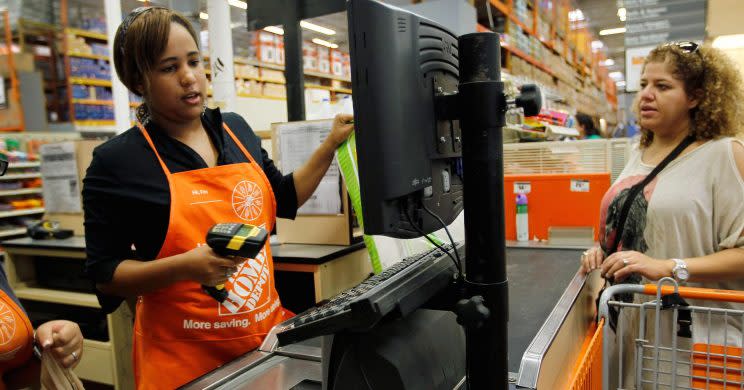Home Depot can still offer one thing Amazon can't
Home Depot had a blowout fourth quarter, beating Wall Street estimates on both the top and bottom lines on Tuesday morning. Though the full-year forecast was a bit weaker than analysts’ expectations, the home improvement retailer has been a major beneficiary of the positive housing picture.
While one might think of the home improvement retailer as a purely in-store play, Home Depot (HD) showed 19% growth in online sales this quarter. The largest home improvement retailer has been doubling down on e-commerce, with its online sales surpassing $4 billion in revenue (compared to only $500 million in 2009), according to a 2016 note from Barclays analyst Matthew McClintock.

Home Depot is not just about e-commerce, though; it has proven its mastery in melding the offline and online shopping experiences for consumers. Home Depot has made a significant push to add more customer-facing employees — making up 60% of the company’s total employees from approximately 40% a decade ago.
Rather than blindly throwing its efforts behind a straightforward e-commerce strategy, Home Depot has seen the utility of enhancing the in-store experience with helpful experts who can help shoppers navigate the vast, cavernous stores. This hands-on, friendly engagement that consumers get at Home Depot’s brick and mortar locations that they simply can’t get from browsing on Amazon.com.
Browse in-store, buy online
Just as many shoppers browse electronic devices in-store at Best Buy (BBY) or sofas from West Elm (WSM), Home Depot’s physical locations are a great place for customers to get advice or demo a product.
Sales associates can then help place your order in-store or you can go home and peruse products at greater length. Home Depot data indicates that departments like flooring, lumber, appliances, plumbing, outdoor and indoor gardens and lighting fixtures sold more than the company’s other departments, on average. Those products often require a very intensive, tactile shopping experience that e-commerce-exclusive companies like Amazon (AMZN) can’t replicate.

Home Depot has dubbed its interconnected retail strategy as “Buy Online, Ship to Store” (BOSS), which provides customers with access to over 300,000 items available for pickup in the stores. The program was fully rolled out by the first quarter of 2013 and gives customers access to over 10 times the number of products stocked in a typical Home Depot store.
Catering to the professional crowd
Rather than focusing on expansion, Home Depot has bolstered its existing store experience. On Tuesday, the company also announced that it would be investing $2 billion of capital in strategic initiatives, stores and customer experience.
Part of expanding on the customer experience involves the company’s “Pro” business, which offers volume pricing discounts for professionals who build and renovate homes for a living. Home Depot’s Pro program caters to a niche audience that actually makes up 40% of the company’s total revenue. Home Depot competitor Lowe’s (LOW) “Pro” model makes up 30% of the company’s total revenue.
Beyond catering to the woodworking hobbyists or homemakers looking to make a quick fix to their homes, Home Depot has developed a loyal customer base, incentivized by cheaper prices when they buy in bulk. For contractors and homebuilders, this makes Home Depot a no-brainer destination.
For the rest of us, it’s clear that home-improvement products often require an in-store shopping experience even while we buy so many other products online. The same underlying trends will likely boost Lowe’s, which reports its fourth quarter results on March 1.
Melody Hahm is a writer at Yahoo Finance, covering entrepreneurship, technology and real estate. Follow her on Twitter @melodyhahm.
Read more by Melody: